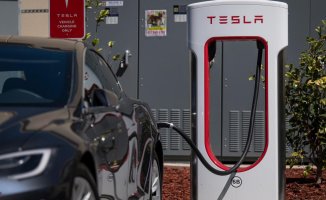The European Union has opened the door so that new internal combustion cars can continue to be sold after 2035 as long as they run on synthetic fuels.
As of today, the battery electric vehicle is the main commitment by institutions and manufacturers to abandon the combustion engine and achieve zero carbon dioxide (CO2) emissions, although it is not defined as a single solution. Other alternatives, such as hydrogen and synthetic fuels, are also being considered, although they are currently further from becoming realistic options.
However, the implementation of the electric car has not been without controversy, focused on factors such as its price, its autonomy, speed and charging infrastructure or the methods used to obtain and recycle its batteries.
Stories, all of them complex, but they tend to lead to oversimplified discussions. A situation that is further magnified in social networks, where any user can provide the information they want -whether true or false- and that millions of users view it, and in which more alternative discourses tend to be successful.
A video that has gone viral in recent weeks on TikTok is the one we are discussing in this article. The video was uploaded to the profile of @easygasgroup, a network of service stations, and then broadcast on other channels with some modification. Since March 21, it has accumulated 1.8 million views on the official profile and 5.3 million more on another channel that shared it.
In the video, a driver who is refueling his car at the pump is asked what type of vehicle he would currently buy: a diesel, a gasoline or an electric one. The protagonist, who claims to have previously worked as an engineer in the emissions department of the Renault Group, explains that he would opt for a diesel or a gasoline one, and classifies the ban on combustion engines in 2035 as a “scam”.
In his speech, the supposed engineer comments on different topics. Among them, he criticizes the electric vehicle for the emissions it generates throughout its life cycle and claims to have evidence that proves him right. He claims to have carried out tests with a 1982 Mercedes 300, with the astonishing figure of 8,200,000 kilometers traveled, and that the results are clear: "It emitted fewer emissions than producing an electric battery." An imprecise statement, since the type of emissions to which it refers (CO2, NOx, PM...) is not specified nor how the emissions of said Mercedes are measured, so it is difficult to make a comparison.
But electric vehicles aren't the only ones that fare poorly in their valuations. Also current cars with heat engines. In the original video he points out that "combustion vehicles, even those from before the 90s, emit fewer emissions than current ones", to later give an example: "We have tests with a 1992 Clio with a 1004 [1.4] engine, which it emits 102 kg [g/km] into the atmosphere, while a gasoline car with the same engine today emits up to 140 kg [g/km],” he adds.
Beyond the inaccuracies, these statements contrast with the data that the Spanish Association of Automobile and Truck Manufacturers (ANFAC) has provided to this medium, regarding the evolution of automobile emissions in recent years. In its 2021 Annual Report (the latest available), it is detailed that the CO2 emissions derived from the registrations of new passenger cars in Spain during 2021 reached 124.3 g/km traveled according to the WLTP measurement regulations.
Taking into account that the Spanish car fleet had an average age of 13.49 years at that time, we will take the year 2007 as a reference. Thus, a car registered in 2021 emitted, on average, 52% less CO2 into the atmosphere than one registered in 2007, according to ANFAC data.
Furthermore, the difference in emissions between new and old cars goes beyond CO2. In 2021, 33.2% of vehicles were not labeled and 31.5% had a DGT B label, these being the cause of 93.5% of polluting NOx emissions and 94.5% of emissions of particles from the entire car park. Again, a car registered in 2021 emits 32% less NOx and particle emissions than one from 2007.
Likewise, from the employers' association they defend that the Euro regulations have led to a reduction of said emissions. They point out that cars registered in 2021, which complied with the current Euro 6d regulations, reduced NOx emissions by 84% compared to 18-year-old cars.
Man is clear that the future lies in "synthetic fuels" and, above all, "hydrogen". In the case of efuels, it is still early to determine what their impact will be on future mobility. For now, it is a little exploited option in the automotive scene.
As for the fuel cell vehicle, he believes that "a couple of things still need to be solved, such as lowering the detonating power", although "fixing that would work". He assures that in any diesel or gasoline car you can install a small tank in which you can put about 20 euros and have a range of up to 1,800 kilometers.













